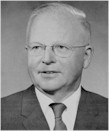

O. J. (Oyvind Juul) Noer (1890-1966)
"This continent's most widely known and
respected turfgrass agronomist"
From his beginnings as a graduating soil scientist from the Department of Soil Science, University of Wisconsin-Madison, O. J. Noer went on to become the State Soil Chemist in 1914, and is credited with helping to establish the first soil testing laboratory in the country. During and after the First World War, he served overseas as captain in the Chemical Warfare Service. From 1922-24 he was in charge of all investigational and experimental work in conjunction with determining the agricultural value of Milorganite under a fellowship grant at the College of Agriculture, University of Wisconsin. But he became best known as Head of the Milwaukee Sewerage Commission Turf Service Bureau from 1926-1960. During this time, O. J. Noer visited/inspected perhaps 80% of the golf courses in North America advising on turf maintenance problems. Noer made many contributions to the diagnosis of turf problems, and wrote and spoke about turf at conferences almost continuously through the period. The ABC of Turf Culture, his 1928 classic, represents one of the earliest integrated works on the subject.
A friend and advisor to all, O. J. Noer was a man "whose educational background, broad experience and intimate contact with the everyday problems of those concerned with growing turf qualify him as an outstanding authority in his field". To honor the only three-time recipient of the GSCAA Distinguished Service Award (1952, 1959 and 1960), the 1960 GCSAA Conference, in Houston, was dedicated to O.J. Noer upon his retirement. In 1963, he received the USGA Green Section Award "For distinguished service to golf through work with turfgrass". His name was entered into the Wisconsin State Golf Association's Hall of Fame at the 1985 Wisconsin Golf Turf Symposium. Before and after his death on July 12, 1966, O. J. Noer has been considered a true pioneer in the turfgrass industry.



O.J. Noer Turfgrass
Research Foundation
Dedicated to Supporting Research in Turf Since 1958
Over $1 million in grants to Turfgrass Research